american samoa, day 2
i've been waking up around 6:45, which is pretty early, but then again, that's almost 11 am back home. my morning routine consists of doing some writing, reviewing my photos from the day before, taking an icy shower and perhaps reading if tar isn't up yet.
(as an aside, i am reading "mark twain's letters from hawaii" which he wrote for the sacramento union when he visited the islands in 1866. he's still a young writer at this point in his life, but it makes for an interesting read nonetheless.)
at around 9, i decided to emerge from my room and walk across the yard to tar's grandmother's house to see if tar is up yet. tar's grandmother is both a kind hostess and a vivacious character. she doesn't speak english so much, although after a few days i am figuring out that she understands a lot more than i originally thought. i've had a lot of conversations with her now, but all are made up of short sentences by both parties. often, after saying something in english, she'll laugh, and i haven't decided if she is amused by her own use of english or if she's being jovial but it's prolly a little of both.
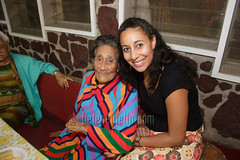
tar & her grandmother
this morning she welcomed me as i walked in, told me tarita was still asleep, and asked if she should wake her. i gave her a conspiratorial nod in agreement. she walked over to the bedroom door, stuck her head in and said "tarita! the boy is up! he is out here. get up and make him breakfast!" tar and i had breakfast similar to that described previously, and i helped her make it.
in the afternoon, peti, tar's mom, took a break from her samoan language conference and we went for a tour of the island. the roads are pretty good here, but it's not like there's an interstate. there's not even a way to circumnavigate the island. mostly driving is done at a mild 20 miles an hour, and the drivers are exceptionally courteous. samoan drivers are constantly yielding their right of way to cars making left turns across their path. people use and also acknowledge turn signals. it's really the complete opposite of california, where drivers are selfish and territorial, impatient and dangerous. "no man is an island" is the rule of the road on this island. but, this can make for some slow going, especially if you get stuck behind and exceptionally safe driver that goes slower than the usual 20 mph.
although there aren't many accidents here, the drives can be mind numbingly slow. a drive to "town", ie the harbor village and capitol city of pago pago can take 45 minutes or more. and it's only 12 miles! growing up in the sticks in ukiah, i know what a 12 mile drive into town is like, and they take things pretty slow up in mendocino county too, but 45 minutes is something else.
pickups rule the road around here, although SUVs are pretty popular. (i've even seen a few SUVs with outlandish dubs and one with spinners). i can count 1 motorcycle and perhaps three or four honda civics. pickups are popular because the elevated suspension is good for some of the less developed roads, it's easier to haul stuff around, but most important--you can cram a whole lot of people in there. besides the buses, which i will write about later, the most common way to get around samoa is in the back of a pickup. it's common to see five or six or eight people piled in the back of a pick-up, and it's not just kids. grandmothers, uncles, brothers, aunties, they all ride in back.
on this afternoon, we traded uncle john his swank toyota 4-runner for his toyota tacoma pick-up and i rode in back with teenagers sam, lu'ai, and tatiana. it's a great feeling to be out in the sun in the back of a slow moving pick-up, but the slow moving traffic on the winding coastal rode makes for a long day. we drove nearly the entire length of the coastal main road that runs along the southern edge of the island. i saw so many charming villages and so much natural beauty that my meager words or modest photographs can do little to describe or represent its scope.
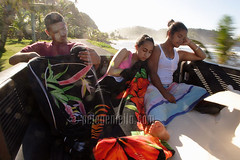
sam (left), tatiana, & lu'ai go for a ride
driving from one side of the island, you get a sense of just how friendly samoans are, as everyone waves and smiles when you go by. i'll talk about samoan kindness and generosity later, but i will say samoa has to be the friendliest place in the world, and their casual and welcoming regard for strangers is abundant.
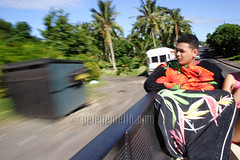
sam in the back of the pick-up
the definite low-light of the day's trip was the tuna canneries. like the beauty of the samoan islands, words cannot describe the awful dry tuna-fishy stench that blows out from the canneries. i am not really sure how people can work there, but the canneries employ 34% of the workforce, and supply 30% of the canned tuna to the mainland. it must be like working at a paper mill or something; after a few days you just can't smell it anymore.
ok. time for a quick geography lesson. there are roughly a dozen samoan islands, with a distinctly western group and an eastern group. the western group is samoa (aka western samoa, aka independent samoa, but locals in both countries call it "samoa"). the eastern group is american samoa; with the majority of the 60,000 residents living on the island of tutuila. tutuila is where we've been staying. i should mention, people freely call the island "pago" because pago pago (pronounced pango pango) is the commercial and government center of the society. when i speak of "samoans" i am usually referring to people from either island group; when i use "samoa" i usually mean the whole.
the biggest disappointment about tutuila is the lack of beaches. i really expected more, but there just isn't any. in fact, despite the lush greenery and rugged landscape, tutuila is kind of worthless. as a volcanic hunk of rock in the middle of the ocean, only about 15% of its land is arable, so naturally, roughly 15% of the land is inhabitable.
the only thing tutuila has going for it is the naturally deep volcanic harbor, with a coastline that encloses it protecting ships from rough seas, while the steep mountains protect the harbor from high winds. naturally, the US navy fell in love with the harbor and built a coaling station there in 1904. theodore roosevelt was president at the time; as a former secretary of the navy, roosevelt made it the country's top priority to build up the navy to be the strongest in the world. in 1907, roosevelt launched the "great white fleet" of 16 brand new battleships (painted gleaming white), which circumnavigated the world as a show of the US's new naval might. in 1908, while the great white fleet cruised the pacific, a squadron of ships was dispatched to pago pago, should the fleet need reinforcements.
so, back to no beaches. there's a few, but the only beach suitable for a tourist such as myself would be tisa's barefoot bar and beach. tisa, an old school chum of peti, runs this legendary beachfront bar with her australian boyfriend, an aus who is totally awes. tisa's bar is like something out of swiss family robinson; everything is improvised, the bar stools are made of coconut tree stumps, and fishing nets are the primary decor.
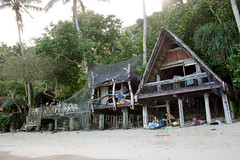
tisa's barefoot bar & beach
we got there after the sun had set over the steep mountainside, so it was kind of cold. the sand was rough, but it sure was nice to get in the water after spending the afternoon in the back of a pick-up. while us kids swam in the ocean, peti went up to the bar to see her old friend (just missed her), but ended up talking to a pair of americans that were staying in tisa's guest cottage. peti forgot their names, but there were big time mountain climbers, having scaled everything from everest on down. they were in samoa to relax and to climb the islands' tallest peaks.
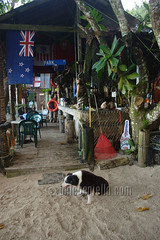
it had been a long day, and we rode back during the samoan rush hour. with only one road around the island, around 5 pm, the roads get clogged with slow moving busses and overloaded pick-ups. again a frustrating experience especially because we had to go from just east of pago pago to about 45 minutes west to leone. in leone we had to drop off the kids, and change into to dinner clothes, and then drive 45 minutes back to pago pago. oka oka!
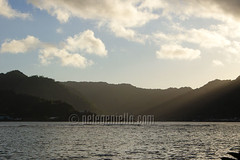
pago pago harbour
because samoa is fairly close to the equator, the sun rises and sets roughly the same time (6:30 and 6:00) year round. in the hour before the sun goes down, samoans of all ages gather in the malae (village commons) and play football (soccer and american) volleyball, etc. to end the day.
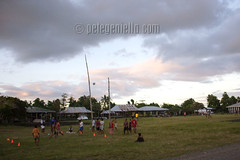
evening sports at a malae
as we rushed back to leone, the hour of 6 was approaching; night was falling. although there are streetlights, it's still pretty dark on the island after the sun sets. bells started ringing. stern looking gentlemen with matching lava-lavas (cloth waist wraps like a sarong, worn by men and women) started lining the road. with their hands on their hips, some holding pipes or sticks, or crossing their thick arms across their chest, it was clear something very serious was going on.
it's an ancient samoan custom the men of the village make sure the night falls without incident, so they stand watch on the streets. they also make sure people hurry home for evening prayers. every village does things its own way. in some villages, the men wear matching lava-lavas in the village colors, while in a larger village like leone, the men cruise around in pick-up trucks. in some villages the curfew lasts for an hour, while in others, everyone must be in for the rest of the night.
tar and i joined her uncle tony and aunty salu for dinner at sadie thompson's inn in pago pago. sadie's is one of the best and oldest restaurants on tutuila. we had the good fortune of salu's company for a second night in a row. her daughter diana was home for two weeks from iraq, so salu has a short break from caring for diana's three children.
sadie's, tony tells me, is named for a famous madame that ran a brothel in the building the restaurant/hotel now occupies. the internet tells me sadie thompson is the main character of the short story "ms. thompson" by somerset maugham about a san francisco prostitute that tries to start anew in pago pago. the story became the play "rain" which was later made into the movie "sadie thompson" starring gloria swanson in the title role. it wouldn't surprise me if both were true.
the dinner was excellent, but the main reason we dined at sadie's was, like the night before, peti was attending a dinner for the samoan language conference. after stuffing our faces, we went to the patio to watch the floor show. sadie’s has the best floor show on the island, the locals tell me, but normally it features dance styles from all over polynesia. because of the language conference, all dances tonight were traditional samoan dances.
the dancers were the waitresses, wearing beautiful red puletasis. a puletasi is a women's formal wear in samoa, made up of a form fitting ankle length skirt and a long, form-fitting top. the patterns are usually colorful and hair is worn in a bun. puletasis are very beautiful and an important part of samoan culture, like the lava-lava, but i can't help but note they represent the westernization of samoan culture, as they came about after christian missionaries de-heathenized the islands. before christianity, women were topless. the puletasi is like the exact opposite; extremely conservative and covering most of the body, although newer designs are more revealing in the bodice.
traditional dancing is an important part of samoan culture, and often i would see women subconsciously making the hand motions to the dance from their seats. which is to say, everyone knows the songs and the moves to the songs. at several points during the show at sadie’s, audience members were called up to dance based on where they lived. peti jumped up on stage when all the californians were called.
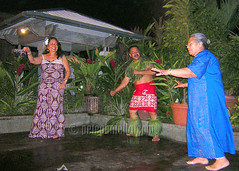
peti dances at sadie's
about halfway through the show, an overwhelming odor blast of gasoline came over the crowd. i thought i was sitting on top of an old lawnmower. all concerns were erased when the fire knife dancers took the stage. the fire knife dance is a traditional samoan dance, which i always thought was hawaiian from TV. it's so traditional and samoan that it was first performed in golden gate park in san francisco in 1946! Letuli Olo Misilagi was about to perform the very traditional samoan knife dance for a shriner's convention, when indian fire-breathers and baton twirlers wowed the audience. letuli upstaged them by lighting his knives on fire, and arguably the most famous expression of polynesian culture was born.
sadie's is a small place, so the we could really feel the heat from the flames, and i got sprayed with gasoline a few times as the dancers whipped the flaming swords around. it was pretty incredible. so incredible, i didn't take pictures. sorry.
alright, well, that's like 2400 words, so i'll stop here. more to come tho.
(as an aside, i am reading "mark twain's letters from hawaii" which he wrote for the sacramento union when he visited the islands in 1866. he's still a young writer at this point in his life, but it makes for an interesting read nonetheless.)
at around 9, i decided to emerge from my room and walk across the yard to tar's grandmother's house to see if tar is up yet. tar's grandmother is both a kind hostess and a vivacious character. she doesn't speak english so much, although after a few days i am figuring out that she understands a lot more than i originally thought. i've had a lot of conversations with her now, but all are made up of short sentences by both parties. often, after saying something in english, she'll laugh, and i haven't decided if she is amused by her own use of english or if she's being jovial but it's prolly a little of both.

tar & her grandmother
this morning she welcomed me as i walked in, told me tarita was still asleep, and asked if she should wake her. i gave her a conspiratorial nod in agreement. she walked over to the bedroom door, stuck her head in and said "tarita! the boy is up! he is out here. get up and make him breakfast!" tar and i had breakfast similar to that described previously, and i helped her make it.
in the afternoon, peti, tar's mom, took a break from her samoan language conference and we went for a tour of the island. the roads are pretty good here, but it's not like there's an interstate. there's not even a way to circumnavigate the island. mostly driving is done at a mild 20 miles an hour, and the drivers are exceptionally courteous. samoan drivers are constantly yielding their right of way to cars making left turns across their path. people use and also acknowledge turn signals. it's really the complete opposite of california, where drivers are selfish and territorial, impatient and dangerous. "no man is an island" is the rule of the road on this island. but, this can make for some slow going, especially if you get stuck behind and exceptionally safe driver that goes slower than the usual 20 mph.
although there aren't many accidents here, the drives can be mind numbingly slow. a drive to "town", ie the harbor village and capitol city of pago pago can take 45 minutes or more. and it's only 12 miles! growing up in the sticks in ukiah, i know what a 12 mile drive into town is like, and they take things pretty slow up in mendocino county too, but 45 minutes is something else.
pickups rule the road around here, although SUVs are pretty popular. (i've even seen a few SUVs with outlandish dubs and one with spinners). i can count 1 motorcycle and perhaps three or four honda civics. pickups are popular because the elevated suspension is good for some of the less developed roads, it's easier to haul stuff around, but most important--you can cram a whole lot of people in there. besides the buses, which i will write about later, the most common way to get around samoa is in the back of a pickup. it's common to see five or six or eight people piled in the back of a pick-up, and it's not just kids. grandmothers, uncles, brothers, aunties, they all ride in back.
on this afternoon, we traded uncle john his swank toyota 4-runner for his toyota tacoma pick-up and i rode in back with teenagers sam, lu'ai, and tatiana. it's a great feeling to be out in the sun in the back of a slow moving pick-up, but the slow moving traffic on the winding coastal rode makes for a long day. we drove nearly the entire length of the coastal main road that runs along the southern edge of the island. i saw so many charming villages and so much natural beauty that my meager words or modest photographs can do little to describe or represent its scope.

sam (left), tatiana, & lu'ai go for a ride
driving from one side of the island, you get a sense of just how friendly samoans are, as everyone waves and smiles when you go by. i'll talk about samoan kindness and generosity later, but i will say samoa has to be the friendliest place in the world, and their casual and welcoming regard for strangers is abundant.

sam in the back of the pick-up
the definite low-light of the day's trip was the tuna canneries. like the beauty of the samoan islands, words cannot describe the awful dry tuna-fishy stench that blows out from the canneries. i am not really sure how people can work there, but the canneries employ 34% of the workforce, and supply 30% of the canned tuna to the mainland. it must be like working at a paper mill or something; after a few days you just can't smell it anymore.
ok. time for a quick geography lesson. there are roughly a dozen samoan islands, with a distinctly western group and an eastern group. the western group is samoa (aka western samoa, aka independent samoa, but locals in both countries call it "samoa"). the eastern group is american samoa; with the majority of the 60,000 residents living on the island of tutuila. tutuila is where we've been staying. i should mention, people freely call the island "pago" because pago pago (pronounced pango pango) is the commercial and government center of the society. when i speak of "samoans" i am usually referring to people from either island group; when i use "samoa" i usually mean the whole.
the biggest disappointment about tutuila is the lack of beaches. i really expected more, but there just isn't any. in fact, despite the lush greenery and rugged landscape, tutuila is kind of worthless. as a volcanic hunk of rock in the middle of the ocean, only about 15% of its land is arable, so naturally, roughly 15% of the land is inhabitable.
the only thing tutuila has going for it is the naturally deep volcanic harbor, with a coastline that encloses it protecting ships from rough seas, while the steep mountains protect the harbor from high winds. naturally, the US navy fell in love with the harbor and built a coaling station there in 1904. theodore roosevelt was president at the time; as a former secretary of the navy, roosevelt made it the country's top priority to build up the navy to be the strongest in the world. in 1907, roosevelt launched the "great white fleet" of 16 brand new battleships (painted gleaming white), which circumnavigated the world as a show of the US's new naval might. in 1908, while the great white fleet cruised the pacific, a squadron of ships was dispatched to pago pago, should the fleet need reinforcements.
so, back to no beaches. there's a few, but the only beach suitable for a tourist such as myself would be tisa's barefoot bar and beach. tisa, an old school chum of peti, runs this legendary beachfront bar with her australian boyfriend, an aus who is totally awes. tisa's bar is like something out of swiss family robinson; everything is improvised, the bar stools are made of coconut tree stumps, and fishing nets are the primary decor.

tisa's barefoot bar & beach
we got there after the sun had set over the steep mountainside, so it was kind of cold. the sand was rough, but it sure was nice to get in the water after spending the afternoon in the back of a pick-up. while us kids swam in the ocean, peti went up to the bar to see her old friend (just missed her), but ended up talking to a pair of americans that were staying in tisa's guest cottage. peti forgot their names, but there were big time mountain climbers, having scaled everything from everest on down. they were in samoa to relax and to climb the islands' tallest peaks.

it had been a long day, and we rode back during the samoan rush hour. with only one road around the island, around 5 pm, the roads get clogged with slow moving busses and overloaded pick-ups. again a frustrating experience especially because we had to go from just east of pago pago to about 45 minutes west to leone. in leone we had to drop off the kids, and change into to dinner clothes, and then drive 45 minutes back to pago pago. oka oka!

pago pago harbour
because samoa is fairly close to the equator, the sun rises and sets roughly the same time (6:30 and 6:00) year round. in the hour before the sun goes down, samoans of all ages gather in the malae (village commons) and play football (soccer and american) volleyball, etc. to end the day.

evening sports at a malae
as we rushed back to leone, the hour of 6 was approaching; night was falling. although there are streetlights, it's still pretty dark on the island after the sun sets. bells started ringing. stern looking gentlemen with matching lava-lavas (cloth waist wraps like a sarong, worn by men and women) started lining the road. with their hands on their hips, some holding pipes or sticks, or crossing their thick arms across their chest, it was clear something very serious was going on.
it's an ancient samoan custom the men of the village make sure the night falls without incident, so they stand watch on the streets. they also make sure people hurry home for evening prayers. every village does things its own way. in some villages, the men wear matching lava-lavas in the village colors, while in a larger village like leone, the men cruise around in pick-up trucks. in some villages the curfew lasts for an hour, while in others, everyone must be in for the rest of the night.
tar and i joined her uncle tony and aunty salu for dinner at sadie thompson's inn in pago pago. sadie's is one of the best and oldest restaurants on tutuila. we had the good fortune of salu's company for a second night in a row. her daughter diana was home for two weeks from iraq, so salu has a short break from caring for diana's three children.
sadie's, tony tells me, is named for a famous madame that ran a brothel in the building the restaurant/hotel now occupies. the internet tells me sadie thompson is the main character of the short story "ms. thompson" by somerset maugham about a san francisco prostitute that tries to start anew in pago pago. the story became the play "rain" which was later made into the movie "sadie thompson" starring gloria swanson in the title role. it wouldn't surprise me if both were true.
the dinner was excellent, but the main reason we dined at sadie's was, like the night before, peti was attending a dinner for the samoan language conference. after stuffing our faces, we went to the patio to watch the floor show. sadie’s has the best floor show on the island, the locals tell me, but normally it features dance styles from all over polynesia. because of the language conference, all dances tonight were traditional samoan dances.
the dancers were the waitresses, wearing beautiful red puletasis. a puletasi is a women's formal wear in samoa, made up of a form fitting ankle length skirt and a long, form-fitting top. the patterns are usually colorful and hair is worn in a bun. puletasis are very beautiful and an important part of samoan culture, like the lava-lava, but i can't help but note they represent the westernization of samoan culture, as they came about after christian missionaries de-heathenized the islands. before christianity, women were topless. the puletasi is like the exact opposite; extremely conservative and covering most of the body, although newer designs are more revealing in the bodice.
traditional dancing is an important part of samoan culture, and often i would see women subconsciously making the hand motions to the dance from their seats. which is to say, everyone knows the songs and the moves to the songs. at several points during the show at sadie’s, audience members were called up to dance based on where they lived. peti jumped up on stage when all the californians were called.

peti dances at sadie's
about halfway through the show, an overwhelming odor blast of gasoline came over the crowd. i thought i was sitting on top of an old lawnmower. all concerns were erased when the fire knife dancers took the stage. the fire knife dance is a traditional samoan dance, which i always thought was hawaiian from TV. it's so traditional and samoan that it was first performed in golden gate park in san francisco in 1946! Letuli Olo Misilagi was about to perform the very traditional samoan knife dance for a shriner's convention, when indian fire-breathers and baton twirlers wowed the audience. letuli upstaged them by lighting his knives on fire, and arguably the most famous expression of polynesian culture was born.
sadie's is a small place, so the we could really feel the heat from the flames, and i got sprayed with gasoline a few times as the dancers whipped the flaming swords around. it was pretty incredible. so incredible, i didn't take pictures. sorry.
alright, well, that's like 2400 words, so i'll stop here. more to come tho.
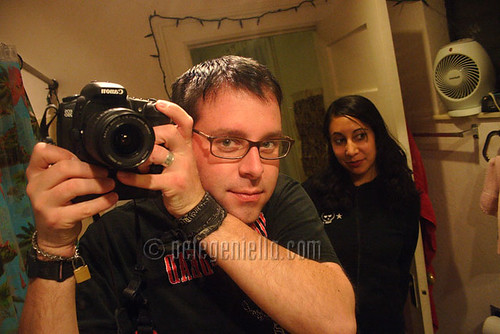

1 Comments:
The rainforests of American Samoa are the most preserved of any Pacific island; Tahiti, Fiji, Samoa
Does that mean anything to you?
I'm citing Art Whistler here.
Does that mean anything to you?
Enjoy the former stink of the former cannery.
Uh oh! Conde Nast calls Ofu "one of the top ten beaches in the world".
Broaden your horizen!
Wad
Post a Comment
<< Home